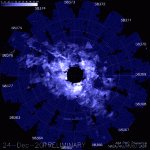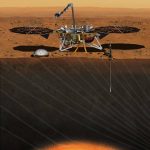NASA’s Juno Orbiter Delivers Spectacular New Photos of Jupiter0
- From Around the Web, Space
- January 10, 2018
NASA has released beautiful new images of Jupiter’s turbulent atmosphere from the tenth close flyby of its Juno spacecraft.

NASA has released beautiful new images of Jupiter’s turbulent atmosphere from the tenth close flyby of its Juno spacecraft.

For the first time, scientists have shown through direct satellite observations of the ozone hole that levels of ozone-destroying chlorine are declining, resulting in less ozone depletion.

Beyond the orbit of Mars, blue Comet PanSTARRS (C/2016 R2) is behaving strangley.

From the pasture to the swamp, methane emissions on Earth are the effluvia of life. So what are whiffs of the gas doing on barren Mars?

Using the now-complete Cassini data set, astronomers have created a new global topographic map of Saturn’s moon Titan that has opened new windows into understanding its liquid flows and terrain.

We’ve had plenty of near-misses in the year of 2017, and now we’re expecting more meteors??

A kilometer-size asteroid slammed into Earth about 800,000 years ago with so much force that it scattered debris across a 10th of our planet’s surface. Yet its impact crater remains undiscovered. Now, glassy remains believed to have come from the strike suggest the asteroid hit southeast Asia as our close ancestors walked the Earth.

NASA’s AIM spacecraft is monitoring a vast ring of electric-blue clouds circling high above Antarctica.

Scientists are one step closer to solving the mystery behind the ‘most mysterious star in the universe.’

2018 is slated to be an exciting year for Nasa and its fans.



